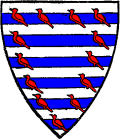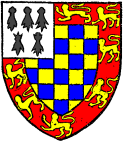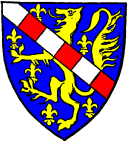
 |
| FIG. 60.--Arms of Aymer de Valence, Earl of Pembroke: "Baruly argent and azure, an orle of martlets gules." (From his seal.) |
 |
| FIG. 61.--The arms of John de Bretagne, Earl of Richmond. |
 |
| FIG. 62.--Arms of John de Beaumont, Lord Beaumont(d. 1369): Azure, semé-de-lis and a lion rampant or, over all a bend gobony argent and gules. (From his seal.) |
 |
| FIG. 63.--A to B, the chief; C to D, the base; A to C, dexter side; B to D, sinister side. A. dexter chief: B, sinister chief; C, dexter base; D, sinister base. 1, 2, 3, chief; 7, 8, 9, base; 2, 5, 8, pale; 4, 5, 6, fess; 5, fess point. |
 |
| FIG. 64. |